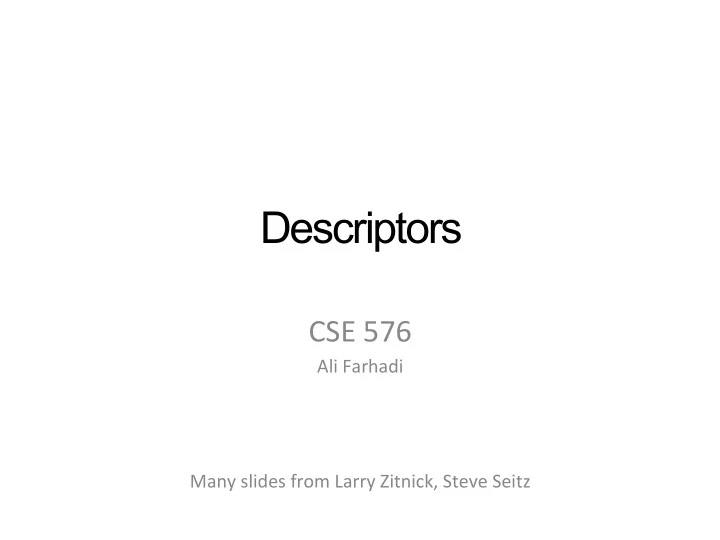

Descriptors CSE ¡576 ¡ Ali ¡Farhadi ¡ ¡ ¡ ¡ Many ¡slides ¡from ¡Larry ¡Zitnick, ¡Steve ¡Seitz ¡
How can we find corresponding points?
How can we find correspondences?
How do we describe an image patch?
How do we describe an image patch? Patches ¡with ¡similar ¡content ¡should ¡have ¡similar ¡descriptors. ¡
Raw patches as local descriptors The simplest way to describe the neighborhood around an interest point is to write down the list of intensities to form a feature vector. But this is very sensitive to even small shifts, rotations.
What do human use? Gabor ¡filters… ¡ … ¡and ¡many ¡other ¡things. ¡
SIFT descriptor Full version • Divide the 16x16 window into a 4x4 grid of cells (2x2 case shown below) • Compute an orientation histogram for each cell • 16 cells * 8 orientations = 128 dimensional descriptor Adapted from slide by David Lowe
SIFT descriptor Full version • Divide the 16x16 window into a 4x4 grid of cells (2x2 case shown below) • Compute an orientation histogram for each cell • 16 cells * 8 orientations = 128 dimensional descriptor • Threshold normalize the descriptor: such that: 0.2 Adapted from slide by David Lowe
Properties of SIFT Extraordinarily robust matching technique • Can handle changes in viewpoint – Up to about 30 degree out of plane rotation • Can handle significant changes in illumination – Sometimes even day vs. night (below) • Fast and efficient—can run in real time • Lots of code available – http://people.csail.mit.edu/albert/ladypack/wiki/index.php/Known_implementations_of_SIFT
Example NASA Mars Rover images with SIFT feature matches Figure by Noah Snavely
Example: Object Recognition SIFT is extremely powerful for object instance recognition, especially for well-textured objects Lowe, IJCV04
Example: Google Goggle
panorama? • We need to match (align) images
Matching with Features • Detect feature points in both images
Matching with Features • Detect feature points in both images • Find corresponding pairs
Matching with Features • Detect feature points in both images • Find corresponding pairs • Use these matching pairs to align images - the required mapping is called a homography.
Automatic mosaicing http://www.cs.ubc.ca/~mbrown/autostitch/autostitch.html
Recognition of specific objects, scenes Sivic and Zisserman, 2003 Schmid and Mohr 1997 Lowe 2002 Rothganger et al. 2003 Kristen Grauman
When does SIFT fail? Patches SIFT thought were the same but aren’t:
Other methods: Daisy Circular gradient binning SIFT Daisy Picking the best DAISY, S. Winder, G. Hua, M. Brown, CVPR 09
Other methods: SURF For computational efficiency only compute gradient histogram with 4 bins: SURF: Speeded Up Robust Features Herbert Bay, Tinne Tuytelaars, and Luc Van Gool, ECCV 2006
Other methods: BRIEF Randomly sample pair of pixels a and b. 1 if a > b, else 0. Store binary vector. Daisy BRIEF: binary robust independent elementary features, Calonder, V Lepetit, C Strecha, ECCV 2010
Feature distance How to define the difference between two features f 1 , f 2 ? • Simple approach is SSD(f 1 , f 2 ) – sum of square differences between entries of the two descriptors – can give good scores to very ambiguous (bad) matches f 1 f 2 I 1 I 2
Feature distance How to define the difference between two features f 1 , f 2 ? • Better approach: ratio distance = SSD(f 1 , f 2 ) / SSD(f 1 , f 2 ’) – f 2 is best SSD match to f 1 in I 2 – f 2 ’ is 2 nd best SSD match to f 1 in I 2 – gives large values (~1) for ambiguous matches f 1 f 2 ' f 2 I 1 I 2
Eliminating bad matches 50 true match 75 200 false match feature distance Throw out features with distance > threshold • How to choose the threshold?
True/false positives 50 true match 75 200 false match feature distance The distance threshold affects performance • True positives = # of detected matches that are correct – Suppose we want to maximize these—how to choose threshold? • False positives = # of detected matches that are incorrect – Suppose we want to minimize these—how to choose threshold?
Local Descriptors: Shape Context Count the number of points inside each bin, e.g.: Count = 4 ... Count = 10 Log-polar binning: more precision for nearby points, more flexibility for farther points. Belongie & Malik, ICCV 2001 K. Grauman, B. Leibe
Recommend
More recommend